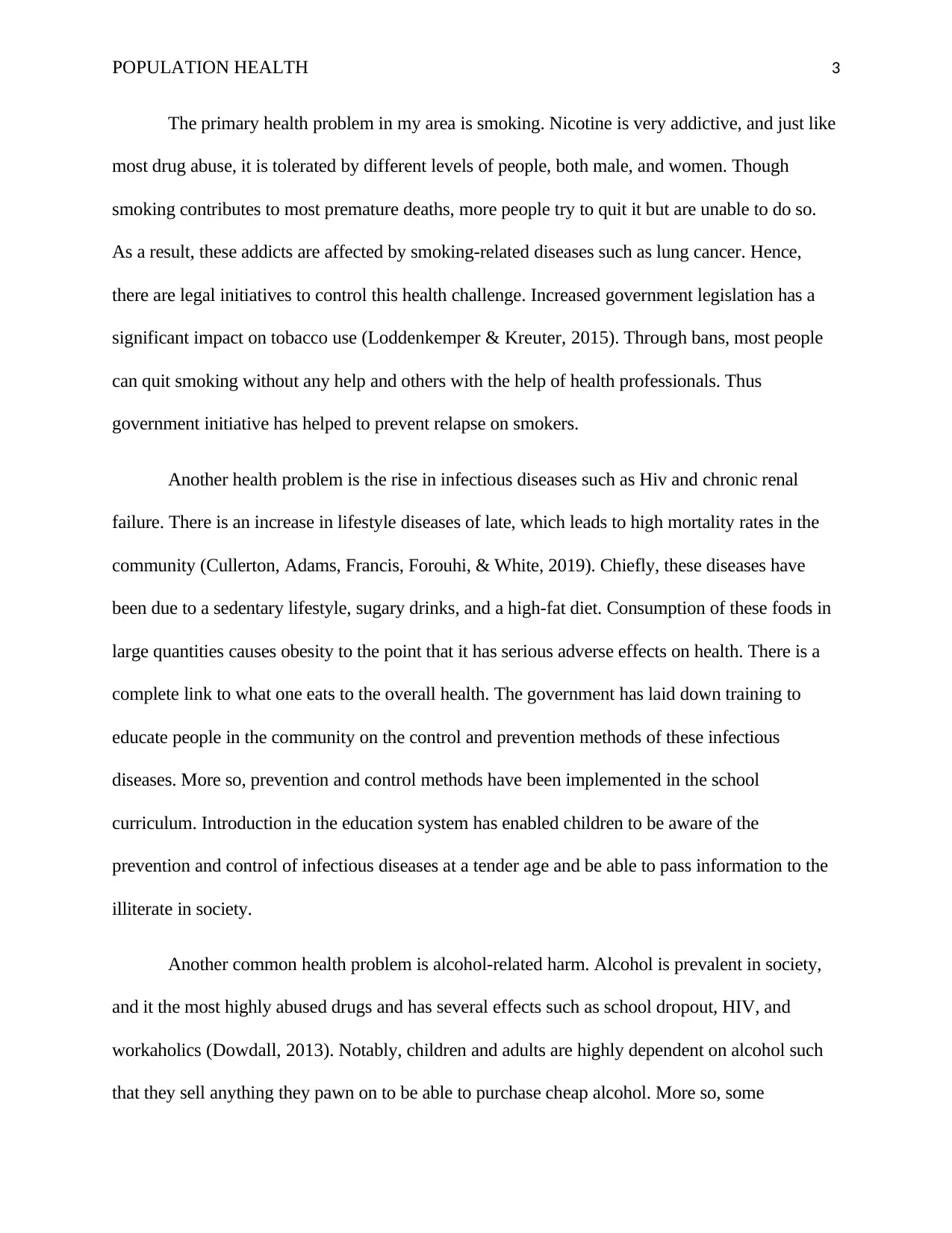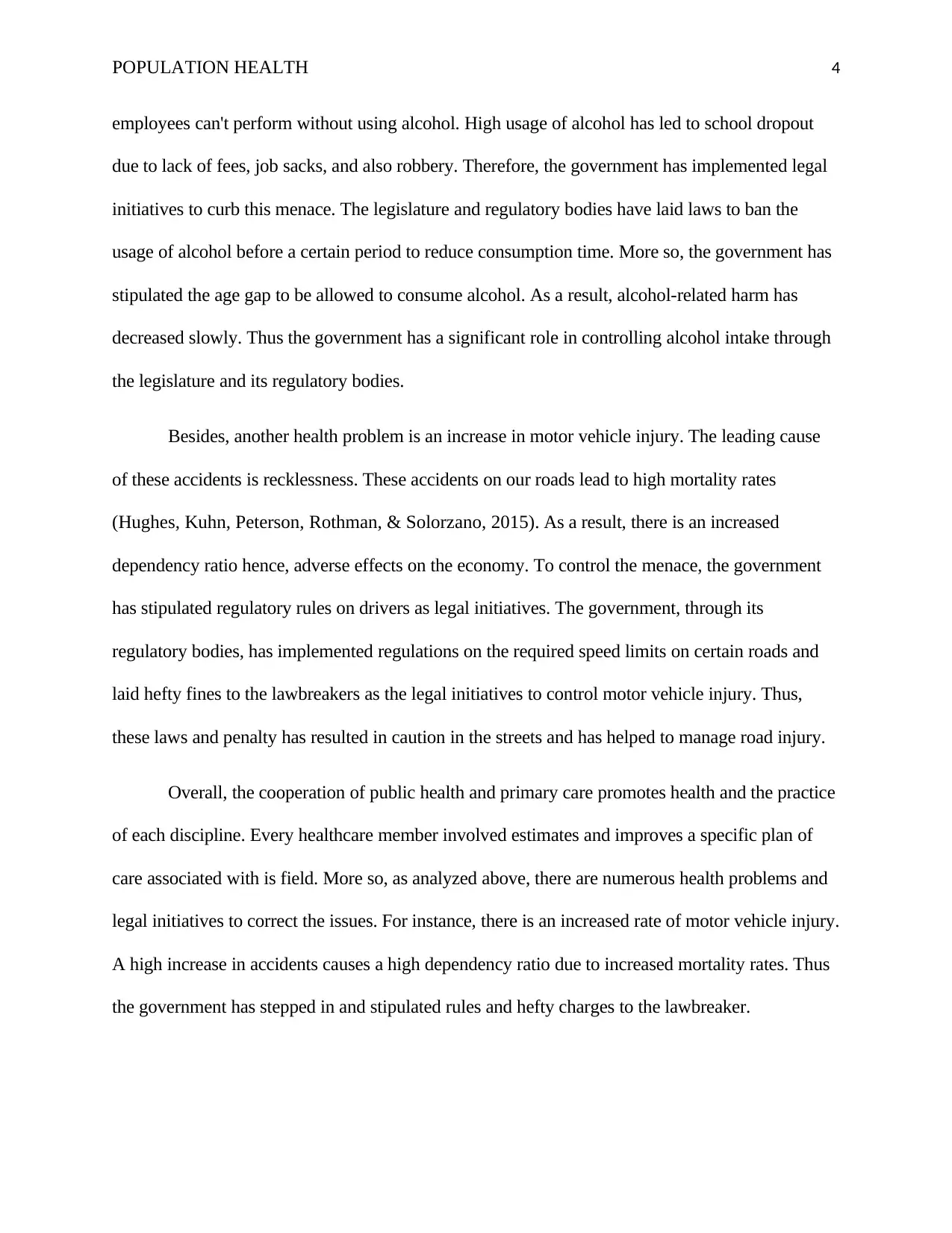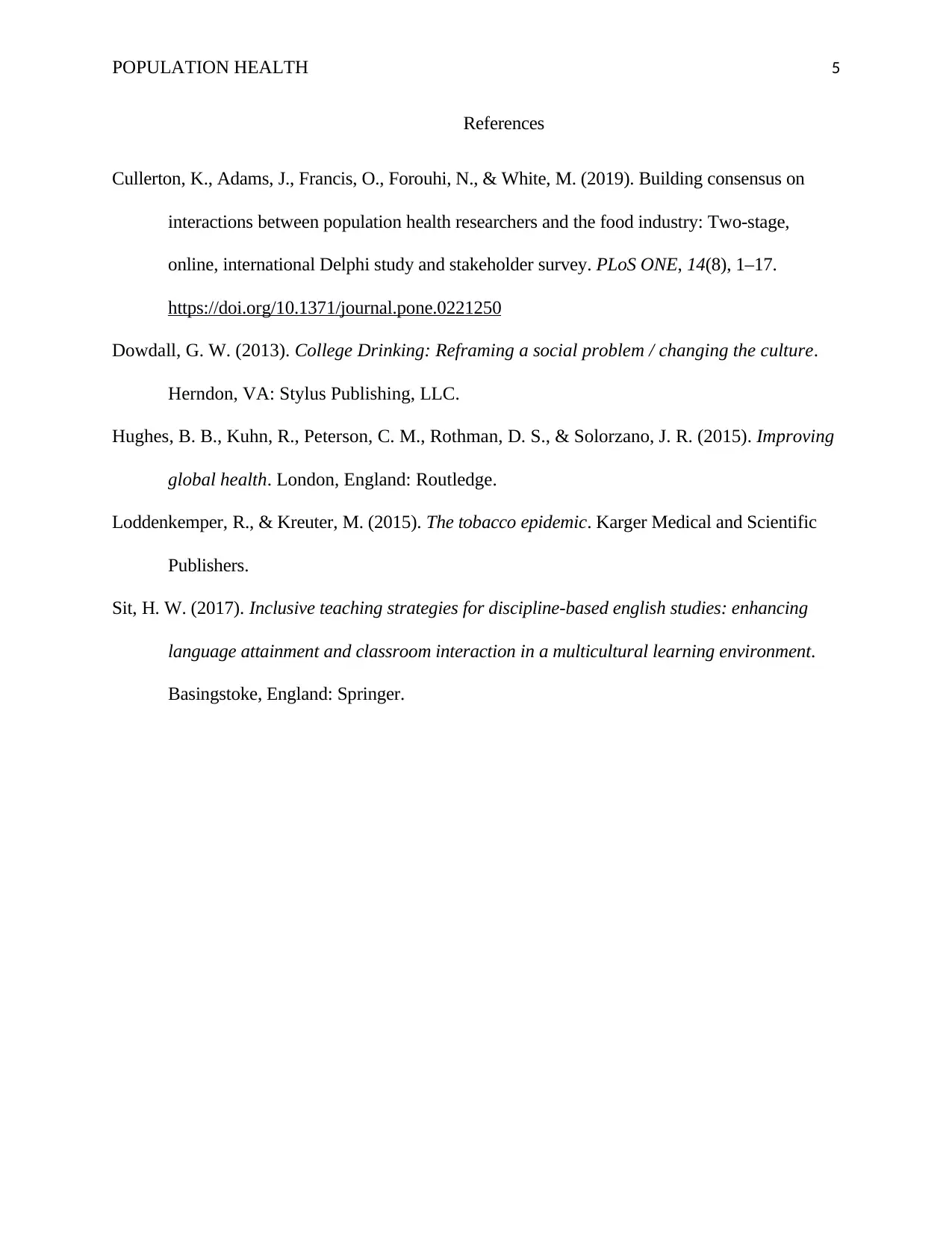Comprehensive Report: Population Health Problems and State Initiatives
VerifiedAdded on 2022/10/02
|5
|1218
|27
Report
AI Summary
This report examines population health in the context of public health and primary care collaboration. It identifies key health problems, including smoking, infectious diseases (HIV, chronic renal failure), alcohol-related harm, and motor vehicle injuries. The report highlights the impact of these issues and explores state-level initiatives designed to address them, such as government legislation, education, and regulatory measures. It also emphasizes the importance of interdisciplinary teamwork and communication in healthcare. The report uses scholarly research and the insights gained from a visit to a local health department to provide a comprehensive overview of the challenges and solutions in population health.

Running head: POPULATION HEALTH 1
Population Health
Student’s Name
Institutional Affiliation
Population Health
Student’s Name
Institutional Affiliation
Paraphrase This Document
Need a fresh take? Get an instant paraphrase of this document with our AI Paraphraser

POPULATION HEALTH 2
Population Health
Introduction
In the contemporary world, most health care disciplines have a collective and primary
commitment to serve patients and to promote health. Primarily, the healthcare system consists of
many varying trained members. Each member has a particular specialty and obligation to the
patient and plays a critical role in the patient’s whole plan of care. The healthcare scope mandates
that health professionals work collaboratively with other correlated disciplines. Cooperation
originates from an understanding and appreciation of the responsibilities and assistance that every
subject brings to the care delivery experience. The following analysis will discuss how public
health and primary care should work together, the population health problems, and state-level
initiatives to correct the issues.
It was vital for public health and primary care to work together. When public health and
primary healthcare work together, they become part of the collaborative team that consists of the
nurses and other professionals providing care to the patient. Thus it is a tactic in which two or more
disciplines cooperate in the learning course with the primary goal of nurturing interprofessional
interactions that promote health and the practice of each subject (Sit, 2017). Every healthcare
member involved estimates and improves a specific plan of care associated with is field. When that
plan is communicated, they discuss thoughts and ideas and keep on reassessing their plans with
every member. As a result, a successful interdisciplinary team develops. Thus, through mutual
respect, team members can cooperate and work towards the achievement of healthcare goals and
objectives.
Population Health
Introduction
In the contemporary world, most health care disciplines have a collective and primary
commitment to serve patients and to promote health. Primarily, the healthcare system consists of
many varying trained members. Each member has a particular specialty and obligation to the
patient and plays a critical role in the patient’s whole plan of care. The healthcare scope mandates
that health professionals work collaboratively with other correlated disciplines. Cooperation
originates from an understanding and appreciation of the responsibilities and assistance that every
subject brings to the care delivery experience. The following analysis will discuss how public
health and primary care should work together, the population health problems, and state-level
initiatives to correct the issues.
It was vital for public health and primary care to work together. When public health and
primary healthcare work together, they become part of the collaborative team that consists of the
nurses and other professionals providing care to the patient. Thus it is a tactic in which two or more
disciplines cooperate in the learning course with the primary goal of nurturing interprofessional
interactions that promote health and the practice of each subject (Sit, 2017). Every healthcare
member involved estimates and improves a specific plan of care associated with is field. When that
plan is communicated, they discuss thoughts and ideas and keep on reassessing their plans with
every member. As a result, a successful interdisciplinary team develops. Thus, through mutual
respect, team members can cooperate and work towards the achievement of healthcare goals and
objectives.

POPULATION HEALTH 3
The primary health problem in my area is smoking. Nicotine is very addictive, and just like
most drug abuse, it is tolerated by different levels of people, both male, and women. Though
smoking contributes to most premature deaths, more people try to quit it but are unable to do so.
As a result, these addicts are affected by smoking-related diseases such as lung cancer. Hence,
there are legal initiatives to control this health challenge. Increased government legislation has a
significant impact on tobacco use (Loddenkemper & Kreuter, 2015). Through bans, most people
can quit smoking without any help and others with the help of health professionals. Thus
government initiative has helped to prevent relapse on smokers.
Another health problem is the rise in infectious diseases such as Hiv and chronic renal
failure. There is an increase in lifestyle diseases of late, which leads to high mortality rates in the
community (Cullerton, Adams, Francis, Forouhi, & White, 2019). Chiefly, these diseases have
been due to a sedentary lifestyle, sugary drinks, and a high-fat diet. Consumption of these foods in
large quantities causes obesity to the point that it has serious adverse effects on health. There is a
complete link to what one eats to the overall health. The government has laid down training to
educate people in the community on the control and prevention methods of these infectious
diseases. More so, prevention and control methods have been implemented in the school
curriculum. Introduction in the education system has enabled children to be aware of the
prevention and control of infectious diseases at a tender age and be able to pass information to the
illiterate in society.
Another common health problem is alcohol-related harm. Alcohol is prevalent in society,
and it the most highly abused drugs and has several effects such as school dropout, HIV, and
workaholics (Dowdall, 2013). Notably, children and adults are highly dependent on alcohol such
that they sell anything they pawn on to be able to purchase cheap alcohol. More so, some
The primary health problem in my area is smoking. Nicotine is very addictive, and just like
most drug abuse, it is tolerated by different levels of people, both male, and women. Though
smoking contributes to most premature deaths, more people try to quit it but are unable to do so.
As a result, these addicts are affected by smoking-related diseases such as lung cancer. Hence,
there are legal initiatives to control this health challenge. Increased government legislation has a
significant impact on tobacco use (Loddenkemper & Kreuter, 2015). Through bans, most people
can quit smoking without any help and others with the help of health professionals. Thus
government initiative has helped to prevent relapse on smokers.
Another health problem is the rise in infectious diseases such as Hiv and chronic renal
failure. There is an increase in lifestyle diseases of late, which leads to high mortality rates in the
community (Cullerton, Adams, Francis, Forouhi, & White, 2019). Chiefly, these diseases have
been due to a sedentary lifestyle, sugary drinks, and a high-fat diet. Consumption of these foods in
large quantities causes obesity to the point that it has serious adverse effects on health. There is a
complete link to what one eats to the overall health. The government has laid down training to
educate people in the community on the control and prevention methods of these infectious
diseases. More so, prevention and control methods have been implemented in the school
curriculum. Introduction in the education system has enabled children to be aware of the
prevention and control of infectious diseases at a tender age and be able to pass information to the
illiterate in society.
Another common health problem is alcohol-related harm. Alcohol is prevalent in society,
and it the most highly abused drugs and has several effects such as school dropout, HIV, and
workaholics (Dowdall, 2013). Notably, children and adults are highly dependent on alcohol such
that they sell anything they pawn on to be able to purchase cheap alcohol. More so, some
⊘ This is a preview!⊘
Do you want full access?
Subscribe today to unlock all pages.

Trusted by 1+ million students worldwide

POPULATION HEALTH 4
employees can't perform without using alcohol. High usage of alcohol has led to school dropout
due to lack of fees, job sacks, and also robbery. Therefore, the government has implemented legal
initiatives to curb this menace. The legislature and regulatory bodies have laid laws to ban the
usage of alcohol before a certain period to reduce consumption time. More so, the government has
stipulated the age gap to be allowed to consume alcohol. As a result, alcohol-related harm has
decreased slowly. Thus the government has a significant role in controlling alcohol intake through
the legislature and its regulatory bodies.
Besides, another health problem is an increase in motor vehicle injury. The leading cause
of these accidents is recklessness. These accidents on our roads lead to high mortality rates
(Hughes, Kuhn, Peterson, Rothman, & Solorzano, 2015). As a result, there is an increased
dependency ratio hence, adverse effects on the economy. To control the menace, the government
has stipulated regulatory rules on drivers as legal initiatives. The government, through its
regulatory bodies, has implemented regulations on the required speed limits on certain roads and
laid hefty fines to the lawbreakers as the legal initiatives to control motor vehicle injury. Thus,
these laws and penalty has resulted in caution in the streets and has helped to manage road injury.
Overall, the cooperation of public health and primary care promotes health and the practice
of each discipline. Every healthcare member involved estimates and improves a specific plan of
care associated with is field. More so, as analyzed above, there are numerous health problems and
legal initiatives to correct the issues. For instance, there is an increased rate of motor vehicle injury.
A high increase in accidents causes a high dependency ratio due to increased mortality rates. Thus
the government has stepped in and stipulated rules and hefty charges to the lawbreaker.
employees can't perform without using alcohol. High usage of alcohol has led to school dropout
due to lack of fees, job sacks, and also robbery. Therefore, the government has implemented legal
initiatives to curb this menace. The legislature and regulatory bodies have laid laws to ban the
usage of alcohol before a certain period to reduce consumption time. More so, the government has
stipulated the age gap to be allowed to consume alcohol. As a result, alcohol-related harm has
decreased slowly. Thus the government has a significant role in controlling alcohol intake through
the legislature and its regulatory bodies.
Besides, another health problem is an increase in motor vehicle injury. The leading cause
of these accidents is recklessness. These accidents on our roads lead to high mortality rates
(Hughes, Kuhn, Peterson, Rothman, & Solorzano, 2015). As a result, there is an increased
dependency ratio hence, adverse effects on the economy. To control the menace, the government
has stipulated regulatory rules on drivers as legal initiatives. The government, through its
regulatory bodies, has implemented regulations on the required speed limits on certain roads and
laid hefty fines to the lawbreakers as the legal initiatives to control motor vehicle injury. Thus,
these laws and penalty has resulted in caution in the streets and has helped to manage road injury.
Overall, the cooperation of public health and primary care promotes health and the practice
of each discipline. Every healthcare member involved estimates and improves a specific plan of
care associated with is field. More so, as analyzed above, there are numerous health problems and
legal initiatives to correct the issues. For instance, there is an increased rate of motor vehicle injury.
A high increase in accidents causes a high dependency ratio due to increased mortality rates. Thus
the government has stepped in and stipulated rules and hefty charges to the lawbreaker.
Paraphrase This Document
Need a fresh take? Get an instant paraphrase of this document with our AI Paraphraser

POPULATION HEALTH 5
References
Cullerton, K., Adams, J., Francis, O., Forouhi, N., & White, M. (2019). Building consensus on
interactions between population health researchers and the food industry: Two-stage,
online, international Delphi study and stakeholder survey. PLoS ONE, 14(8), 1–17.
https://doi.org/10.1371/journal.pone.0221250
Dowdall, G. W. (2013). College Drinking: Reframing a social problem / changing the culture.
Herndon, VA: Stylus Publishing, LLC.
Hughes, B. B., Kuhn, R., Peterson, C. M., Rothman, D. S., & Solorzano, J. R. (2015). Improving
global health. London, England: Routledge.
Loddenkemper, R., & Kreuter, M. (2015). The tobacco epidemic. Karger Medical and Scientific
Publishers.
Sit, H. W. (2017). Inclusive teaching strategies for discipline-based english studies: enhancing
language attainment and classroom interaction in a multicultural learning environment.
Basingstoke, England: Springer.
References
Cullerton, K., Adams, J., Francis, O., Forouhi, N., & White, M. (2019). Building consensus on
interactions between population health researchers and the food industry: Two-stage,
online, international Delphi study and stakeholder survey. PLoS ONE, 14(8), 1–17.
https://doi.org/10.1371/journal.pone.0221250
Dowdall, G. W. (2013). College Drinking: Reframing a social problem / changing the culture.
Herndon, VA: Stylus Publishing, LLC.
Hughes, B. B., Kuhn, R., Peterson, C. M., Rothman, D. S., & Solorzano, J. R. (2015). Improving
global health. London, England: Routledge.
Loddenkemper, R., & Kreuter, M. (2015). The tobacco epidemic. Karger Medical and Scientific
Publishers.
Sit, H. W. (2017). Inclusive teaching strategies for discipline-based english studies: enhancing
language attainment and classroom interaction in a multicultural learning environment.
Basingstoke, England: Springer.
1 out of 5
Related Documents
Your All-in-One AI-Powered Toolkit for Academic Success.
+13062052269
info@desklib.com
Available 24*7 on WhatsApp / Email
![[object Object]](/_next/static/media/star-bottom.7253800d.svg)
Unlock your academic potential
Copyright © 2020–2025 A2Z Services. All Rights Reserved. Developed and managed by ZUCOL.





